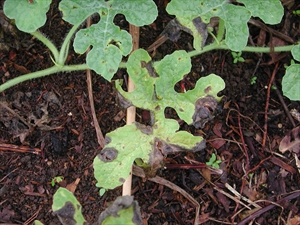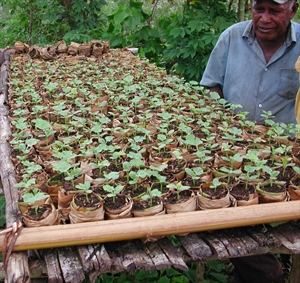Gummy stem blight
Pacific Pests, Pathogens, Weeds & Pesticides - Online edition
Pacific Pests, Pathogens, Weeds & Pesticides
Watermelon gummy stem blight (007)
Stagonosporopsis cucurbitacearum; previously, Didymella bryoniae. Also known by the asexual state, Phoma cucurbitacearum or Ascochyta cucumis. The latter is commonly found on plants in the field producing minute oval spores in round black structures in the leaf called 'pycnidia' that are just visible to the naked eye.
Asia, Africa, North, South and Central America, the Caribbean, Europe, Oceania. The fungus is recorded on cucurbits from Australia, American Samoa, Fiji, Federated States of Micronesia, French Polynesia, New Caledonia, New Zealand, Palau, Samoa, Solomon Islands, Tonga, and Vanuatu.
Watermelon, cantaloupe melon and cucumber.
Spots occur on the leaves, grow rapidly and the leaves blacken, shrivel and die (Photos 1&2). It happens so quickly that it is called a 'blight'. Spots occur on the vines, and they can release a gummy (sticky) substance - hence the name of the disease. Infection of the fruit is uncommon.
The loss of leaves, and the damage to the vines, means that the fruits are starved of food, and do not develop properly.
The fungus produces small, black, round structures inside the leaf spots; they can just be seen with the naked eye, although they are clearer with a hand lens. These are tiny 'sacs' that contain millions of spores.
Fruit rots develop if leaves are severely infected. Small over to round spots occur with a greasy green colour and these turn dark brown to black as they enlarge. The fruiting bodies may develop in the spots.
When they are ready, and when it rains, the baskets burst open and the spores ooze out. Wind and rain carry the spores to other leaves of the same plant, to other plants or to plants in other gardens. When the spores land on watermelon leaves, they germinate like a seed. The fungus enters the leaf and grows inside. As it grows, it kills the leaf, forming the round, brown spots. The spots grow and join together. Then more baskets of spores develop, and the cycle starts again (Diagram).
If the disease is not controlled when first seen, it spreads very quickly, especially during days of heavy and continuous rain. It is common for whole crops to be ruined by gummy stem blight.
In the nursery, look for large brown spots on the leaves (Photos 3&4). In the field, look for the rapid development of black spots and blotches that are typical of this disease, especially during wet weather.
Note, farmers sometimes mistake the disease for damage caused by caterpillars of a moth, Diaphania indica. These roll the leaves with silk threads and eat the parts between the veins (see Fact Sheet No. 33).
CULTURAL CONTROL
Before planting:
-
Carefully choose the soil and site for the nursery:
-
Take soil only from areas where watermelon has not been grown before.
-
Make the nursery far away from watermelon gardens.
-
Do not make the nursery downwind from watermelon gardens (otherwise the wind and rain will blow spores onto the nursery).
-
-
In the nursery do the following:
-
Check for leaf spots, at least every 2 days. If spots are present, remove the plants and burn them.
-
If there are many spots, do not use any of the seedlings; throw them away and start again.
-
Sterilise the soil and/or spray the next lot of seedlings with a fungicide.
-
Sterilise the soil by heating it for one hour, either (i) in a half 44-gallon drum over a fire, or (ii) in an earth oven over hot stones, with the soil covered with banana leaves.
-
-
Do not plant watermelon next to older crops that already have gummy stem blight.
During growth:
- After planting, check the seedlings at least twice a week. If spots are seen on the leaves, remove them to delay the spread of the disease.
After harvest:
- Collect and burn the debris as soon as the harvest has finished.
- Do not plant watermelons in the same land as the last crop. Leave a break of 3 years. The fungus can survive in the soil, living on plant remains. Rotate with sweet potato, cassava, taro, but not with crops in the cucurbit family, such as cucumber, pumpkin and melon.
RESISTANT VARIETIES
In Solomon Islands, variety trials with farmers found that the disease was less on New Dragon.
CHEMICAL CONTROL
Use one of the following fungicides: chlorothalonil, mancozeb or copper oxychloride. Spray every 7-10 days, depending on the weather.
____________________
When using a pesticide, always wear protective clothing and follow the instructions on the product label, such as dosage, timing of application, and pre-harvest interval. Recommendations will vary with the crop and system of cultivation. Expert advice on the most appropriate pesticide to use should always be sought from local agricultural authorities.
AUTHORS Helen Tsatsia & Grahame Jackson
Information from CABI (2019) Didymella bryoniae (gummy stem blight of cucurbits). Invasive Species Compendium. (https://www.cabi.org/isc/datasheet/18900); and from DAF (2016) Gummy stem blight. Queensland Government. (https://www.daf.qld.gov.au/business-priorities/agriculture/plants/fruit-vegetable/diseases-disorders/gummy-stem-blight).
Produced with support from the Australian Centre for International Agricultural Research under project PC/2010/090: Strengthening integrated crop management research in the Pacific Islands in support of sustainable intensification of high-value crop production, implemented by the University of Queensland and the Secretariat of the Pacific Community.








